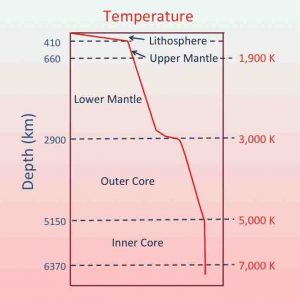
Geothermal gradient is the rate of increasing temperature with respect to increasing depth in the Earth’s interior. Away from tectonic plate boundaries, it is about 25 °C per km of depth (1 °F per 70 feet of depth) near the surface in most of the world.
Strictly speaking, geo-thermal necessarily refers to the Earth but the concept may be applied to other planets. A line tracing the gradient through the planetary body is called a geotherm on Earth and other terrestrial planets. On the Moon it is called a selenotherm.
The Earth’s internal heat comes from a combination of residual heat from planetary accretion, heat produced through radioactive decay, and possibly heat from other sources.
The major heat-producing isotopes in the Earth are potassium-40, uranium-238, uranium-235, and thorium-232. At the center of the planet, the temperature may be up to 7,000 K and the pressure could reach 360 GPa(3.6 million atm). Because much of the heat is provided by radioactive decay, scientists believe that early in Earth history, before isotopes with short half-lives had been depleted, Earth’s heat production would have been much higher. Heat production was twice that of present-day at approximately 3 billion years ago, resulting in larger temperature gradients within the Earth, larger rates of mantle convection and plate tectonics, allowing the production of igneous rocks such as komatiites that are not formed anymore today.










